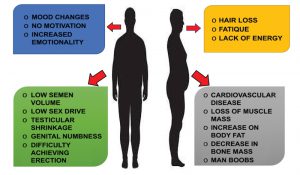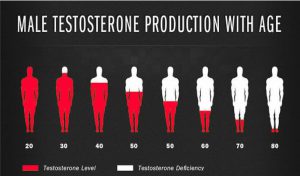SIGNS OF LOW TESTOTERONE

What happens to testosterone levels with age?
Testosterone levels generally peak during adolescence and early adulthood. As you get older, your testosterone level gradually declines — typically about 1 percent a year after age 30 or 40. It is important to determine in older men if a low testosterone level is simply due to the decline of normal aging or if it is due to a disease (hypogonadism).
Hypogonadism is a disease in which the body is unable to produce normal amounts of testosterone due to a problem with the testicles, or with the pituitary gland that controls the testicles. Testosterone replacement therapy can improve the signs and symptoms of low testosterone in men. Doctors may prescribe testosterone as injections, pellets, patches or gels.
How is testosterone injection given?
Testosterone is injected into a muscle. The injection is usually given every 2 to 4 weeks.
Testosterone injections should be given only by a healthcare professional. Misuse can lead to serious side effects or death.
The length of treatment will depend on the condition being treated.
Testosterone will not enhance athletic performance and should not be used for that purpose.
While receiving this medicine, you will need frequent blood tests.
 What should avoid while receiving testosterone injection?
What should avoid while receiving testosterone injection?
To make sure testosterone is safe for you, tell your doctor if you have:
heart disease or coronary artery disease;
a history of heart attack, stroke, or blood clot;
diabetes;
enlarged prostate;
high cholesterol or triglycerides (a type of fat in
 the blood);
the blood);breast cancer (in men, or in women who have hypercalcemia);
liver or kidney disease;
high calcium levels;
if you take a blood thinner (warfarin, Coumadin, Jantoven).
** STARTING PRICE 1,000-THB: 1 INJECTION **

